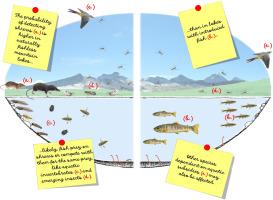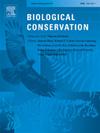引进的鱼类减少了高山湖泊中鼩鼱的数量
IF 4.9
1区 环境科学与生态学
Q1 BIODIVERSITY CONSERVATION
引用次数: 0
摘要
在原本无鱼的高山湖泊中广泛引入鱼类对本地生物群造成了严重后果,其中包括水生大型无脊椎动物,它们为鼩鼱(鼩鼱科)等陆生和半水生食虫动物提供了重要的食物补助。由于鱼类和鼩鼱都依赖水生大型无脊椎动物作为食物,无论是幼虫阶段还是成虫阶段,因此我们研究了鱼类的存在是否会对鼩鼱产生不利影响。我们在意大利阿尔卑斯山西部有鱼和无鱼的湖泊中放置了诱饵管,通过收集鼩鼱的粪便来监测鼩鼱的存在与否。结果发现,只有瓦莱州鼩鼱(Sorex antinorii)和欧亚水鼩鼱(Neomys fodiens)这两种鼩鼱栖息在湖边,以水生昆虫为食。结果表明,鼩鼱与引进鱼类之间存在明显的排斥模式。这种负面关系在大型鱼类(即鲑科鱼类)和小型鱼类(即鲤科鱼类)之间尤为明显。同样,与自然无鱼湖泊相比,有鱼湖泊的水生猎物较少,而水生猎物在两种鼩鼱的食物中都占很大比例。总之,我们的研究结果表明,对鼩鼱的影响可能是由鱼类和鼩鼱之间复杂的竞争和捕食相互作用促成的。鱼类的影响可能会超出湖泊范围,延伸到周边地区的食虫哺乳动物。我们建议,在制定保护和恢复计划时,应考虑到对依赖水生补助的物种和栖息地的潜在益处,并将这些发现传达给公众,以促进对恢复工作的更大支持。本文章由计算机程序翻译,如有差异,请以英文原文为准。

Introduced fish reduce the occurrence of shrews in alpine lakes
Widespread fish introductions into originally fishless mountain lakes have had severe consequences for native biota, including aquatic macroinvertebrates, which provide important food subsidies for terrestrial and semiaquatic insectivores like shrews (Fam. Soricidae). Since both fish and shrews rely on aquatic macroinvertebrates as food, whether in their larval or imaginal stage, we investigated if fish presence had adverse effects on shrews. Baited tubes were deployed to monitor the presence/absence of shrews by collecting their scats in lakes with and without fish in the western Italian Alps. Only two species, the Valais shrew (Sorex antinorii) and the Eurasian water shrew (Neomys fodiens), were found inhabiting the lakes' edges, where they fed on aquatic insect subsidies. The results indicate a significant pattern of exclusion between shrews and introduced fish. This negative association was especially evident in the presence of large-bodied fish (i.e., salmonids), but also of small fish (i.e., cyprinids). Consistently, compared to naturally fishless lakes, those with fish exhibit a lower availability of aquatic prey, representing a significant portion of the diet of both shrew species. Overall, our findings suggest that the impact on shrews may be mediated by a complex interplay of competition and predation between fish and shrews. Fish impacts may extend beyond the lakes to insectivorous mammals in surrounding areas. We recommend that the potential benefits to species and habitats reliant on aquatic subsidies be considered and integrated into conservation and restoration plans, and that these findings be communicated to the public to foster greater support for restoration efforts.
求助全文
通过发布文献求助,成功后即可免费获取论文全文。
去求助
来源期刊

Biological Conservation
环境科学-环境科学
CiteScore
10.20
自引率
3.40%
发文量
295
审稿时长
61 days
期刊介绍:
Biological Conservation is an international leading journal in the discipline of conservation biology. The journal publishes articles spanning a diverse range of fields that contribute to the biological, sociological, and economic dimensions of conservation and natural resource management. The primary aim of Biological Conservation is the publication of high-quality papers that advance the science and practice of conservation, or which demonstrate the application of conservation principles for natural resource management and policy. Therefore it will be of interest to a broad international readership.
 求助内容:
求助内容: 应助结果提醒方式:
应助结果提醒方式:


